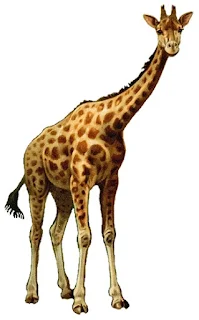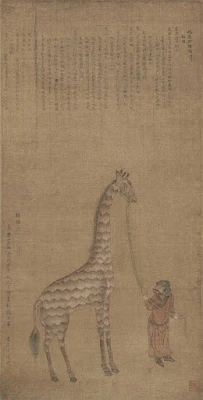30+ Interesting Facts About Giraffes
- The giraffe is the tallest animal on land. Male giraffes usually reach between 4.6 and 5.5 m (15-18 ft.) in height. Their height at birth is usually 1.8 m (6 ft.). The giraffe that holds the record of the tallest land animal is a 12-year-old male in Australia Zoo, Queensland. The height of this tallest giraffe is 5.7 m (18 ft. 8 in.). (Source)
- There are four species and nine subspecies of giraffes. These species do not interbreed in the wild. All the subspecies are limited to various parts of Africa. (Source)
- Okapi is the closest relative of the giraffe. Okapi shares several features with giraffes, like body shape, fur, ossicones, teeth, tongue, and stomach. However, it has a very short height and neck compared to a giraffe. They are known as forest giraffes or rainforest zebra (due to the black and white stripes on their legs).
- Giraffes attain their full height by four years of age. They continue to gain weight up to 8 years. The average weight of giraffes is between 1,750 to 2,800 lbs.
- Giraffes live in savannahs, grasslands, and open forests. They prefer a hot climate in a vast space that allows them to see their predators from a distance. They do not have territorial behavior and live in harmony with other animals in these areas. They live freely in several national parks in Africa.
- Giraffes mostly eat leaves, fruits, and flowers. Their favorite food is the leaves of the acacia tree. Males eat from higher branches of trees and leave lower branches for comparatively shorter females. Females have a more nutritious diet compared to males. They eat up to 75 pounds of food in a day. They can go without water for days in the wild but can drink up to 10 gallons a day when water is available.
- Giraffes have excellent senses of sight, smell, and hearing. They are one of the few mammals that have color vision.
- Lions and crocodiles are the main predators of giraffes, while Juveniles are also hunted by leopards, hyenas, and wild dogs. Giraffes can defend themselves with good sight, deadly kicks, and fast speed. They live for 15 to 25 years in the wild, which is longer than other ruminants.
- Currently, less than 100,000 giraffes are alive. These mammals were reduced by 40% between 1985 and 2015. Habitat destruction, poaching, and conflicts are the main reasons behind this decline. The number of giraffes fell by 60% in Kenya, Ethiopia, and Somalia. The Nubian giraffe is close to extinction after reduction of their population by 97%. (Source)
- The giraffe’s prehensile tongue is 45 to 50 cm long. The thick papillae and saliva protect the tongue and mouth from the thorny plants they eat. The purplish-black color of the tongue is helpful for sunburn protection.
- Like fingerprints in humans, the spotted coats in giraffes are individual for each giraffe. No two giraffes have similar coats.
- Unique patches in giraffes are primarily for camouflage. But the skin underneath these blotches contains a specific system of blood vessels that acts as thermoregulatory. (Source)
- In
Congo, giraffes are killed for their tails. The tail is considered a status symbol
in a few communities and given as a dowry at weddings. (Source)

Giraffe has a unique running style - Giraffe name in English comes from an Arabic word that means “fast walker.” Giraffes only have two gaits: pacing and galloping. Their maximum speed is around 35 mph, while they can run at 30 mph for a couple of miles. Its style of running is unique among mammals. (Source)
- Giraffes have the shortest sleep requirement among mammals. They sleep for just 30 minutes a day. Despite having such height, they usually sleep lying on the ground. (Source)
- The height of giraffes depends heavily on their extremely long necks, which can reach up to 7 feet. They have seven vertebrae in their necks, similar to humans and most other mammals. However, the length of each vertebra can be 10 inches or more. This long neck assists in getting food from tall trees and viewing predators from a distance. (Source)
- Other ungulates (especially zebras) take advantage of the company of giraffes to avoid predators, thanks to the clear vision and high reach of giraffes.
- Giraffes are vegetarians but occasionally lick the bones of a carcass to fulfill their high calcium and phosphorus requirements. (Source)
- Despite their size, giraffes are generally harmless to humans. But at times, they can attack and even kill human beings. (Source)
- There are several noticeable differences between male and female giraffes. Males have thicker horns (ossicones) with smoothed hairs compared to thinner horns with dense hairs in females. Males may grow the second pair of horns behind the initial pair. Males are less social and clash with other males through “necking” and with their horns. Females do not fight with each other.
- A group of giraffes is known as a tower. There are usually 10 to 20 members in a group, but their numbers can reach up to 50. This group is comprised of females, young giraffes, and some adult male giraffes. Few bull giraffes like to stay solitary.
- Male giraffes change the color of their blotches from sienna brown to coal-black before reaching ten years. The maximum age for male giraffes in the wild is 21 to 22 years. (Source)
- Giraffes can make several types of noises. During a threat, they snort or hiss while females call the young by a bellow. They also make low-frequency humming noises at night. (Source)
- Male giraffes use necking to establish mating rights in their social structure. In a few instances, the two males only check each other’s strength by rubbing necks. But it can become serious at other times when two bachelors give powerful neck blows to each other. On some occasions, this fight ends with the death of an opponent. (Source)
- It is a wrong assumption that most male giraffes show homosexual behavior through necking. In fact, most of these giraffes display dominance through this behavior. (Source)
- Giraffes were commonly depicted in wall
paintings of ancient Egypt. They were part of diplomacy in ancient and modern
history. (Source)

Giraffes are depicted in ancient wall paintings - The giraffe has a smaller heart compared to its body size. But it can pump blood to the brain with a powerful beat, thanks to the thick walls of the left ventricle. The heartbeat and blood pressure in giraffes are twice than that of humans. (Source)
- Giraffes were considered good pollinators of Acacia trees due to their height. But a study shows that giraffes are flower predators instead of pollinators. (Source)
- The ancestors of giraffes in Africa initially appeared around 6 million years ago. Modern giraffes emerged on earth nearly 1 million years ago. (Source)
- Like humans, giraffes also have 32 teeth. They lack upper front teeth, while most of their teeth are at the back of their mouth.
- Giraffes have tight skin around their extremities that assist in moving body fluid against gravity. The skin in various body parts assists in the regulation of blood flow and provides protection. (Source)
- Male giraffes can prepare a strong aroma in their skins. They can produce these 11 smelly chemicals in sweat or oil glands that act as antibiotics and parasite repellents. (Source)
- Giraffes have the longest tails among land mammals, reaching up to 8 feet (2.4 meters). But several other mammals and animals have longer tails related to their bodies. (Source)



Comments
Post a Comment